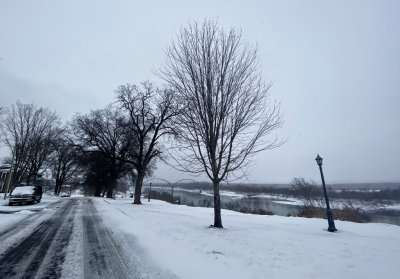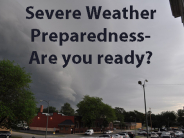Severe Weather Awareness
Snow and Ice
Safety Resources:
- How the City of Leavenworth clears snow
- Kansas Department of Transportation or call "511"
- Missouri Department of Transportation or call "511"
Snow and ice season in Kansas can begin as early as October and end in April. Each year is unique, and each snow storm is unique. De-icing begins prior to a snowstorm with a brine solution. Street crews will continue to treat hot spots throughout the City during and after the storm. The City no longer uses sand. The solutions we use are limited and cannot melt ice below a certain temperature, so we urge caution when traveling.
Snow on streets
City street crews begin clearing snow starting on Emergency Snow Routes when two inches or more of snow has accumulated. We begin with Emergency Snow Routes, then move to residential routes. Crews then move to clear downtown routes and parking lots.
-
What if I'm homebound/in need of immediate medical care? Our snow plow crews work directly with the emergency and ambulance staff to make sure they can get to you in time of need.
Snow on sidewalks
Property owners are responsible for removing snow from adjacent sidewalks and sidewalk ramps. Businesses are responsible for clearing sidewalks downtown. The City allows owners 24 hours following the conclusion of the snowstorm to properly remove snow from all the aforementioned areas. Residents will be held responsible for knowing that whenever snow has accumulated to such a depth that snow removal operations will be required. Snow removal is necessary for safety.
Tornadoes
Get prepared for this type of severe weather emergency from the experts at FEMA: https://www.ready.gov/tornadoes
- Tornado Watch: The National Weather Service' Storm Prediction Center can issue a Tornado Watch. This means tornadoes are possible in and near the watch area. Review and discuss emergency plans. Identify safe locations such as an interior room in your home, basement or other shelter. Typically they will issue a watch in a specific county, so tune into your All-Hazards Weather Radio or local radio or television news station for more information and listen for "Leavenworth County."
-
Tornado Warning: A tornado warning means that a tornado has been sighted or indicated by weather radar. The National Weather Service recommends moving to an interior room on the lowest floor of a sturdy building. Avoid windows. If in a mobile home, a vehicle, or outdoors, move to the closest substantial shelter and protect yourself from flying debris. Warnings are issued by your local forecast office. Warnings typically encompass a much smaller area (around the size of a city or small county) that may be impacted by a tornado identified by a forecaster on radar or by a trained spotter/law enforcement who is watching the storm.
Flash Flooding
The term "flash flooding" is used to describe a flooding event that can come without warning. There may not be time for local officials to warn the public or update traveller information maps with closed road data. If there is water on the road, do not try to drive through. Just one foot of moving water can sweep away your vehicle - and water may be much deeper than it seems if there is an unseen dip in the road.
Check out FEMA's flooding preparation tips here: https://www.ready.gov/floods
Severe Heat
In eastern Kansas, severe heat can come in the summer months when temperatures and high humidity exceed 90 degrees Fahrenheit for several days. Here are some tips on how to stay safe during a heat wave: https://www.ready.gov/heat



